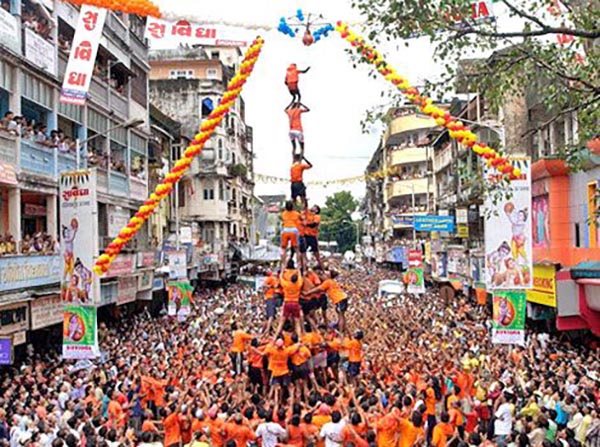
Gokulashtami or Krishna Janmashtami or Krishna Jayanthi marks the celebration of the birth of Lord Krishna. It is a very auspicious day especially for the Hindus and being celebrated across the world.Gokul is the name of the place where Lord Krishna was born and brought up and who has been worshipped as the eighth incarnation of Vishnu-the supreme deity. The birth of Vishnu’s incarnation was to bring joy and give security to the suffering humanity and to destroy the cruel king Kansa of Mathura.
According to the story, the king of Mathura, Kansa was very arrogant and cruel tyrant. His cruelty, tyranny and demon nature spared no one including sages, who had to bear the brunt of this.

Unable to tolerate no more the tyranny of Kansa,Kansa was told by the Gods in the dream that his evil reign would come to an end through his sister Devaki’s son, who would kill him. Sensing some danger to his life, the cowardly tyrant immediately put his sister Devaki and her husband Vasudev in prison so that he could kill all the sons born to Devaki.
While they were in the captivity, Devaki gave birth to six sons, each of whom were promptly killed by Kansa. When Devaki gave birth to her eighth child, the newly born baby changed himself into the form of Vishnu and commanded Vasudev to carry him to Nandgaon and place him besides Yasodha. That night the prison guards fell into a deep slumber and the doors were unlocked. Taking advantage of this opportunity, Vasudev slipped out of the prison and whisked away the God-child to the safety a neighboring kingdom which was ruled by king Nanda. King Nanda’s domain lay across the Yamuna River. At that time the river Yamuna was high, but when Baby Krishna’s feet touched the waters, the waters parted making a channel for Vasudev to pass.

He was also asked to bring back the baby girl whom Yashoda had delivered. The generous king Nanda gave away his new born daughter to Vasudev knowing fully aware that what fate would await her at Kansa’s hands. Vasudev brought back the baby girl. Seeing the baby girl, the enraged King Kansa smashed her on the wall but she escaped his hands and flew away to heaven announcing -“Beware, your killer is alive”.

At Gokul, under king Nanda’s protection, Krishna got the loving affection of King Nanda’s Queen Yashoda whom Krishna looked upon as a mother. Days passed with fun and frolic, while the child-Krishna grew up. Krishna grew up happy in Nandgaon amongst cowherds. His flute-playing enthralled the young girls or “gopis” who danced around him. The cows gathered with his sweet flute playing. But one day rumors reached Kansa that Devaki’s son had somehow escaped his clutches and was living in Gokul.
You will notice that the theme of “Krishna with his Gopis” is a favorite among many Rajasthani paintings.

Krishna was ideal in all his human relationships – a darling son to his parents, an endearing friend and comrade, a devoted disciple, a loving husband and a trusted brother. There are many stories that tell about his superhuman qualities and mystical achievements.
In spite of this Sri Krishna never appeared distant to any of his fellow human beings, in fact he was dearer to them than their own nearest kith and kin. The shadow of his greatness never marred these bonds of the heart. To the Hindu, he is the supreme statesman, warrior, hero, philosopher, teacher and god himself.
Lord Krishna was born on ‘Ashtami day’ or the eighth day after Raksha Bandhan in the month of ‘SHRAAVAN’ and was born in the dark half of the month and at the darkest hour of midnight. He is considered to be one of Lord Vishnu’s most glorious incarnations. He is popularly known as a naughty child, an inspired cowherd, a destroyer of demons, an enthralling flute-player, a divine lover and a clever diplomat. Lord Krishna is also known as Govinda, Gopala and Kanhaiya and always shown in his pictures with his flute or Bansuri.

Gokulashtami celebrations are held over two days. The first day is Krishnashtami or Gokulashtami.The second day is called Kalastami or more popularly.
How is Gokulashtami celebrated?
On the auspicious day of Gokulashtami, Hindu households and devotees decorate their houses as if they are going to welcome Lord Krishna, imprint a child’s footprint from the door to the prayer room signifying the coming of Baby Krishna into their homes and prepare sweets as offering to the Lord. Butter which is believed to be Lord Krishna’s favorite is also offered. Seekers of truth observe fast throughout the day and break the fast at midnight when the Lord is believed to have been born. This is followed by devotional songs on the Lord.
The Lord’s childhood pranks and leelas are made popular in the western state of Maharashtra by people enacting the Krishna’s childhood attempts to steal butter and curd from earthen pots beyond his reach as mentioned in the Lord’s biography the Srimád Bhagavatam. A butter filled pot is suspended high above the ground and groups form human pyramids to try and reach the pot and break it. There is also a cash prize attached to the event. The prize depends on the height of suspension of the pot.
Significance of Lord Krishna
The incarnation of Krishna represents the descent of the infinite to the finite material world. Even his costume has a deep significance for the devotee. The symbolism of Lord Krishna in his costume as found in many artistic images around the world is described by H.H.Swami Chinmayananda as ‘The ever smiling Lotus – eyed Krishna, with a garland of flowers around His neck, is described as being blue in colour and wearing yellow clothes. Blue is the color of the infinite and whatever is immeasurable can appear to the mortal eye only as blue, like the sky and the ocean. Yellow represents the earth.
Anything buried in the earth gathers a yellow hue; and fire earth (mud silica) emits a yellow hue. Hence, the finite blue form of Krishna clothed in yellow appropriately suggests the pure infinite Consciousness. The one infinite Reality has become the world of endless forms. Therefore, every form in the universe, in a sense, is but a representation of a primeval Truth.”
Dahi Handi:-
Another most popular, funny and frolic part of ceremony “Dahi Handi” takes place on the second day of celebrations. Though it is the part of ritual, being celebrated to commemorate the Lord Krishna’s birth in a grand scale with the involvement of all the people regardless of their caste, religion and language. It is the moment to cherish, merrymaking and to enjoy to the fullest.

Krishna Vesha competition will be held in different places especially for the children. The prizes are also being given to those who fares well in the competition. Besides that there are some dramas depicting the life story of Lord Krishna also being played.A special Pooja will be performed in the temple and various types of sweets for offering to Lord Krishna being prepared and are distributed to the people.
Special Laddu called “Krisha Laddu”- bit harder than the other normal Laddu-favourite of Lord Krishna is also being prepared and distributed among the people. The entire area wore a complete festive look in the each nook and corner during this period. Although objective may be the same, variation in celebration in different parts of the country might be observed.
‘Dahi Handi’ is nothing but an earthen pot or “matka” or “handi” filled with curds, milk, curds, butter, honey, fruits and “jvari” is tied from a high rope about 20 to 40 feet high. The rope also has prize money tied to it. This prize money is distributed among those who participate in the building the pyramid. It is a spectacular sight to see. Many people especially potters (Kumbhara) are busy preparing pots (earthen pots-Matka) for the occasion and doing roaring business.
Young men form a human pyramid to break the pot. To do so they climb, constructing a human pyramid by standing over each other’s shoulders till the pyramid is tall enough to enable the person at the top to reach the pot and claim the contents after breaking it.
A popular image of Krishna was and still is……Krishna stealing dahi or butter from an earthen pot. During his childhood, the naughty and adventurous Lord Krishna along with his mates used to raid the houses of his neighbors in search of milk and butter, they too would build a human pyramid and plunder the pots of milk and butter. This ceremony replicates Krishna’s love for milk and butter.
Once the pot is broken, the contents are eaten as “prasad” amidst acclamations of “Govind” which is another name for Krishna.
“WISHING ALL THE KANNADIGAWORLD READERS” A VERY HAPPY AND PROSPEROUS GOKULASHTAMI.
Shekar Moily



Comments are closed.